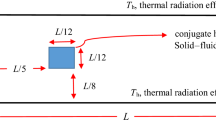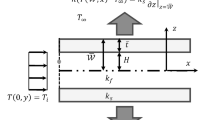Abstract
A new hybrid method is proposed for solving the problems of fluid dynamics and heat transfer in complex hydraulic systems. The peculiarity of the method consists in the idea that some elements of the model are represented as network elements, where the solving of the flow distribution problem is carried out on the basis of the hydraulic circuit theory, whereas the flow in the remaining elements is calculated by the spatial methods of computational fluid dynamics (CFD). The results are presented of testing the proposed hybrid method for the problems of fluid dynamics and heat transfer in microchannels. The test calculations demonstrate high efficiency of the method.
Similar content being viewed by others
References
A. P. Merenkov and V. Ya. Khasilev, Theory of Hydraulic Circuits (Nauka, Moscow, 1985) [in Russian].
N. N. Novitskii, E. V. Sennova, M. G. Sukharev, et al., Hydraulic Circuits. Theory Development and Applications (Nauka, Novosibirsk, 2000) [in Russian].
D. J. Twigt, E. D. De Goede, F. Zijl, D. Schwanenberg, and A. Y. W. Chiu, “Coupled 1D–3D Hydrodynamic Modelling with Application to the Pearl River Delta,” Ocean Dynamics 59, 1077–1093 (2009).
W. Zhang, S. Lyu, Yu. Zhu, and X. Chen, “A Coupled Model of the 1D River Network and 3D Estuary Based on Hydrodynamics and Suspended Sediment Simulations,” J. Appl. Math. (2014) URL: http://dx.doi.org/10.1155/2014/798579.
C. D’Angelo and A. Quarteroni, On the Coupling of 1D and 3D Diffusion-Reaction Equations. Applications to Tissue Perfusion Problems, MOX-Report No. 28/2008.
E. D. Fernandez-Nietoa, J. Marinb, and J. Monnierc, “Coupling Superposed 1D and 2D Shallow-Water Models: Source Terms in Finite Volume Schemes,” Computers & Fluids 39, 1070–1082 (2010).
L. Formaggia, F. Nobile, A. Quarteroni, and A. Veneziani, “Multiscale Modelling of the Circulatory System: A Preliminary Analysis,” Computing and Visualization in Sci. No. 2, 75–83 (1999).
H. Harvey et al., “A Hybrid 1D and 3D Approach to Hemo Dynamics Modelling for a Patient-Specific Cerebral Vasculature and Aneurysm,” in Lecture Notes in Computer Science, Vol. 5762 (Springer, Heidelberg, 2009), pp. 323–330.
E. V. Astrakhantseva, V. Yu. Gidaspov, and D. L. Reviznikov, “Mathematical Modeling of Hemodynamics of Large Blood Vessels,” Mat. Model. 17 (8), 61–80 (2005).
A. F. Voevodin and V. S. Nikiforovskaya, “Numerical Modeling of Unsteady-State Hydrothermal Processes in Water Objects,” in International Conference “Modern Problems of Applied Mathematics and Mechanics: Theory, Experiment, and Practice” Dedicated to the 90th Anniversary of Academician N. N. Yanenko (Inst. Teoret. Prikl.Mekh., Novosibirsk, 2011), p. 16.
T. K. Dobroserdova, Numerical Modeling of Blood Flow under Presence of Vascular Implants or Pathology, Candidate’s Dissertation inMathematics and Physics (Inst. Vychisl.Mat.,Moscow, 2013).
J. Alastruey, K. H. Parker, J. Peirò, and S. J. Sherwin, “Lumped Parameter Outflow Models for 1D Blood Flow Simulations: Effect on Pulse Waves and Parameter Estimation,” Comm. Comput. Phys. 4 (2), 317–336 (2008).
S. I. Fadeev, E. G. Kostsov, and D. O. Pimanov, “Numerical Study of Mathematical Models of Microelectromechanical Resonators of Various Types,” Sibirsk. Zh. Industr. Mat. 17 (4), 120–135 (2014) [J. Appl. Indust. Math. 9 (1), 47–60 (2015)].
V. Ya Rudyak, A. V. Minakov, A. A. Gavrilov, and A. A. Dekterev, “Application of New Numerical Algorithm for Solving the Navier–Stokes Equations for Modelling theWork of a Viscometer of the Physical Pendulum Type,” Thermophysics and Aeromechanics 15, 333–345 (2008).
V. Ya Rudyak, A. V. Minakov, A. A. Gavrilov, and A. A. Dekterev, “Modelling of Flows in Micromixers,” Thermophysics and Aeromechanics 17, 565–576 (2010).
V. Ya. Rudyak, A. V. Minakov, A. A. Gavrilov, and A. A. Dekterev, “Mixing in a T-Shaped Micromixer at Moderate Reynolds Numbers,” Thermophysics and Aeromechanics 19, 385–395 (2012).
A. Minakov, V. Rudyak, A. Dekterev, and A. Gavrilov, “Investigation of Slip Boundary Conditions in the T-Shaped Microchannel,” Internat. J. Heat and Fluid Flow 43, 161–169 (2013).
A. A. Gavrilov, A. V. Minakov, A. A. Dekterev, and V. Ya. Rudyak, “A Numerical Algorithm for Modeling Laminar Flows in an Annular Channel with Eccentricity,” Sibirsk. Zh. Industr. Mat. 13 (4), 3–14 (2010) [J. Appl. Indust. Math. 5 (4), 559–568 (2011)].
A. V. Minakov, “Numerical Algorithm for Moving-Boundary Fluid Dynamics Problems and Its Testing,” Zh. Vychisl.Mat. Mat. Fiz. 54 (1), 61–72 (2014) [Comput.Math.Math. Phys. 54 (10), 1560–1570 (2014)].
A. A. Dekterev, A. A. Gavrilov, and A. V. Minakov, “Up-to-Date Features of the CFD Code SigmaFlow for Solving the Thermal Physical Problems,” Sovremennaya Nauka: Issled., Idei, Result., Tekhnol. 4 (2), 117–122 (2010).
A. A. Gavrilov, A. V. Minakov, A. A. Dekterev, and V. Ya. Rudyak, “A Numerical Algorithm for Modeling Laminar Flows in an Annular Channel with Eccentricity,” Sibirsk. Zh. Industr. Mat. 13 (4), 3–14 (2010) [J. Appl. Indust. Math. 5 (4), 559–568 (2011)].
N. N. Novitskii, M. G. Sukharev, S. A. Sardanashvili, et al., “A Hybrid Approach to Solution of the Problems of Theory of Hydraulic Circuits That Include Some Space Elements,” in Pipeline Systems of Energetics: Mathematical and Computer Modeling (Melentiev Energy Systems Inst., Irkutsk, 2014), pp. 46–55.
S. A. Filimonov, A. A. Dekterev, and D. V. Boikov, “Numerical Modeling of a Shell-and-Tube Heat- Exchanger by a Hybrid Algorithm,” Teplovye Protsessy v Tekhnike 6 (8), 343–348 (2014).
S. V. Patankar, Numerical Heat Transfer and Fluid Flow (Hemisphere, Washington, 1980; Energoatomizdat, Moscow, 1984).
X.-Q. Wang, A. S. Mujumdar, and C. Yap, “Thermal Characteristics of Tree-Shaped Microchannel Nets for Cooling of a Rectangular Heat Sink,” Intern. J. Thermal Sci. 45, 1103–1112 (2006).
S. Khandekar, G. Agarwal, and M. K. Moharana, “Thermo-Hydrodynamics of Developing Flow in a Rectangular Mini-Channel Array,” in Proceedings of the 20th National and 9th International ISHMT-ASME Heat and Mass Transfer Conference (Bombay, 2010), pp. 1342–1349.
A. S. Lobasov, A. V, Minakov, and A. A. Dekterev, “Modeling of Hydrodynamics and Convective Heat Transfer in Microchannels,” Vychisl. Mekh. Sploshn. Sred 5 (4), 481–488 (2012).
Author information
Authors and Affiliations
Corresponding authors
Additional information
Original Russian Text © S.A. Filimonov, A.A. Dekterev, A.V. Sentyabov, A.V. Minakov, 2015, published in Sibirskii Zhurnal Industrial’noi Matematiki, 2015, Vol. XVIII, No. 3, pp. 86–97.
Rights and permissions
About this article
Cite this article
Filimonov, S.A., Dekterev, A.A., Sentyabov, A.V. et al. Simulation of conjugate heat transfer in a microchannel system by a hybrid algorithm. J. Appl. Ind. Math. 9, 469–479 (2015). https://doi.org/10.1134/S1990478915040031
Received:
Published:
Issue Date:
DOI: https://doi.org/10.1134/S1990478915040031




